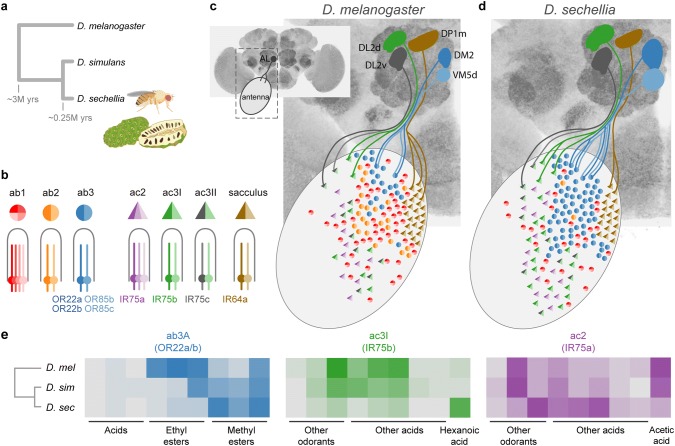Fig. 2.
Evolution of peripheral olfactory circuits in Drosophila sechellia. a Phylogenetic relationships among three closely related Drosophila, showing D. sechellia and its preferred noni fruit. b Types of sensilla and associated OSNs that are discussed in the text and depicted in panels c, d. Receptor names shown for only a subset of cells. Note that Or22b is co-expressed with Or22a in the ab3A neuron of D. melanogaster but is a pseudogene in D. sechellia. Conversely, Or85c is co-expressed with Or85b in the ab3B neuron of D. sechellia, but possibly not in D. melanogaster. Receptor-OSN pairing is otherwise conserved. c, d, Schematics showing divergence in sensilla/OSN number and glomerulus size between D. melanogaster (c) and D. sechellia (d). Populations of sensilla that have expanded include ab3 (blue circles) and ac3I (green triangles). Those that have contracted or been almost completely lost include ab1 (red circles), ab2 (orange circles), and sacculus neurons (brown triangles). Axonal projections leading to glomeruli in the AL are only shown for a subset of key OSNs. The position and abundance of sensilla are adapted from Dekker et al. (2006), Shanbhag et al. (1999), and Prieto-Godino et al. (2017). e Heatmaps showing divergence in sensillum/OSN tuning between D. melanogaster, D. simulans, and D. sechellia. Names of relevant receptor proteins are shown in parentheses below sensillum/OSN name. In each case, either sensitivity to key components of noni fruit odor has increased (e.g., ab3A and ac3I) or sensitivity to odorants that were ancestrally important but emitted by ripe noni in only trace amounts have decreased (e.g., ac2). Data are adapted from Prieto-Godino et al. (2017) and Auer et al. (2019)

